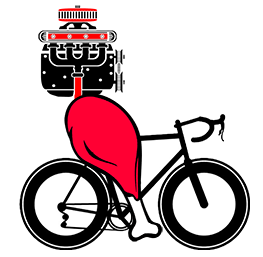These two studies looked at cycling HIIT training’s effects on running performance. It seems that HIIT training does help running performance to a degree.
Study One Summary
The Effect of Different Recovery Intervals in High-Intensity Cycling Training on Running Performance
A recent study examined how the ratio of work-to-rest intervals during high-intensity interval cycling training (HIIT) impacts running performance and endurance. The researchers wanted to determine the most effective cycling HIIT protocol for long-distance runners.
Thirty-two long-distance runners (14 men, 18 women) with an average of 25 miles of weekly running were split into four groups. Each group did six 10-second maximal effort sprints on a stationary bike with different rest periods in between: 30 seconds (R30), 80 seconds (R80), 120 seconds (R120), or no sprints (control group). Before and after two weeks of cycling HIIT, the runners did a 3K run test, a test to determine their maximal oxygen uptake (VO2 max), and a Wingate test which measures peak anaerobic power and capacity.
The R30 group significantly improved their 3K run time by 3.1%, whereas the R80 and R30 groups significantly increased their time to exhaustion, a measure of endurance, by 6.4% and 4.4% respectively. However, average and peak power (measures of anaerobic power) during the Wingate test increased the most in the R80 and R120 groups, by 4.6-5.3% and 8.5% respectively.
In conclusion, cycling-based HIIT improves running performance in long-distance runners. The type and extent of improvement depends on the work-to-rest interval. Shorter rest periods of 30-80 seconds maximize endurance gains, whereas longer rest periods of 80-120 seconds maximize anaerobic power gains. Endurance athletes can utilize cycling HIIT with a range of work-to-rest intervals in their training to target specific performance outcomes.
Study Two Summary
The Effect of Short vs. Long High-Intensity Cycling Intervals on Cycling and Running Performance in Triathletes
The optimal type of high-intensity interval training (HIIT) for cycling in triathletes is not well understood. This study compared the effects of short, higher intensity intervals vs. longer, lower intensity intervals during cycling HIIT on both cycling and running performance in triathletes.
Fourteen moderately trained male triathletes did an initial test to determine their maximal oxygen uptake (VO2max) and other measures. They then did either 16 short (10, 20 and 40 seconds) or long intervals (5 minutes) of high-intensity cycling, followed by one hour of triathlon-specific cycling and a 5K run. After three weeks of six HIIT sessions, they repeated the initial testing.
VO2max improved by ~7% in both groups. Power output during the final short sprints improved by 10% in both groups. Heart rate, blood lactate, and perceived exertion decreased during the hour of cycling for both groups but only the long interval group improved their 5K run time, by over one minute.
In summary, both short and long high-intensity cycling intervals can improve cycling fitness in triathletes. However, long 5-min cycling intervals may improve running performance more than short 10-40 second intervals. For the best all-around triathlon performance, triathletes should incorporate a mix of both shorter and longer high-intensity intervals into their cycling training.
Areas of Agreement Between The Two Studies
Both studies found that high-intensity interval training (HIIT) on a stationary bike improves cycling performance in endurance athletes, specifically endurance and power output. In both studies, longer interval durations of around 5 minutes led to greater improvements in running performance compared to shorter intervals of 30-120 seconds. The longer intervals seemed to have a greater impact on endurance that transferred to running. Both studies found improvements in maximal oxygen uptake (VO2max), a measure of cardiovascular fitness, with HIIT. The increases were similar between the short and long interval groups. The studies agreed that while shorter intervals may maximize some measures of cycling performance like anaerobic power, longer intervals are needed to significantly improve running performance. A mix of short and long intervals is ideal. The conclusions of both studies are limited to an extent by small sample sizes and short study durations. More research is still needed to determine optimal HIIT protocols.
Abstract One
High-Intensity Cycling Training: The Effect of Work-to-Rest Intervals on Running Performance Measures
High-intensity cycling training: the effect of work-to-rest intervals on running performance measures. J Strength Cond Res 29(8): 2229–2236, 2015—The work-to-rest ratio during cycling-based high-intensity interval training (HIT) could be important in regulating physiological and performance adaptations. We sought to determine the effectiveness of cycling-based HIT with different work-to-rest ratios for long-distance running. Thirty-two long-distance runners (age: 39 ± 8 years; sex: 14 men, 18 women; average weekly running training volume: 25 miles) underwent baseline testing (3-km time-trial, V[Combining Dot Above]O2peak and time to exhaustion, and Wingate test) before a 2-week matched-work cycling HIT of 6 × 10-second sprints with different rest periods (30 seconds [R30], 80 seconds [R80], 120 seconds [R120], or control). Three-kilometer time trial was significantly improved in the R30 group only (3.1 ± 4.0%, p = 0.04), whereas time to exhaustion was significantly increased in the 2 groups with a lower work-to-rest ratio (R30 group 6.4 ± 6.3%, p = 0.003 vs. R80 group 4.4 ± 2.7%, p = 0.03 vs. R120 group 1.9 ± 5.0%, p = 0.2). However, improvements in average power production were significantly greater with a higher work-to-rest ratio (R30 group 0.3 ± 4.1%, p = 0.8 vs. R80 group 4.6 ± 4.2%, p = 0.03 vs. R120 group 5.3 ± 5.9%, p = 0.02), whereas peak power significantly increased only in the R80 group (8.5 ± 8.2%, p = 0.04) but not in the R30 group (4.3 ± 6.1%, p = 0.3) or in the R120 group (7.1 ± 7.9%, p = 0.09). Therefore, cycling-based HIT is an effective way to improve running performance, and the type and magnitude of adaptation is dependent on the work-to-rest ratio.
Journal of Strength and Conditioning Research 29(8):p 2229-2236, August 2015
Authors: Kavaliauskas, Mykolas; Aspe, Rodrigo R.; Babraj, John
Abtract Two
High-intensity cycle interval training improves cycling and running performance in triathletes
Effective cycle training for triathlon is a challenge for coaches. We compared the effects of two variants of cycle high-intensity interval training (HIT) on triathlon-specific cycling and running. Fourteen moderately-trained male triathletes (O2peak 58.7 ± 8.1 mL kg−1 min−1; mean ± SD) completed on separate occasions a maximal incremental test (
O2peak and maximal aerobic power), 16 × 20 s cycle sprints and a 1-h triathlon-specific cycle followed immediately by a 5 km run time trial. Participants were then pair-matched and assigned randomly to either a long high-intensity interval training (LONG) (6–8 × 5 min efforts) or short high-intensity interval training (SHORT) (9–11 × 10, 20 and 40 s efforts) HIT cycle training intervention. Six training sessions were completed over 3 weeks before participants repeated the baseline testing. Both groups had an ∼7% increase in
O2peak (SHORT 7.3%, ±4.6%; mean, ±90% confidence limits; LONG 7.5%, ±1.7%). There was a moderate improvement in mean power for both the SHORT (10.3%, ±4.4%) and LONG (10.7%, ±6.8%) groups during the last eight 20-s sprints. There was a small to moderate decrease in heart rate, blood lactate and perceived exertion in both groups during the 1-h triathlon-specific cycling but only the LONG group had a substantial decrease in the subsequent 5-km run time (64, ±59 s). Moderately-trained triathletes should use both short and long high-intensity intervals to improve cycling physiology and performance. Longer 5-min intervals on the bike are more likely to benefit 5 km running performance.
European Journal of Sport Science Volume 14, 2014 – Issue 6
Authors: Naroa Etxebarria, Judith M. Anson, David B. Pyne & Richard A. Ferguson
https://www.tandfonline.com/doi/abs/10.1080/17461391.2013.853841
Listen to the Two Minute Audio Summary

Jordan Fowler has experience as a head swimming coach of the Frisco Swim Team, a TAAF-awarded coach, a track and field distance running consultant for select Texas High School runners, and has competed as a triathlete, road runner, and cyclist. Though he is remarkably slower than he was in his 20s and 30s, he still enjoys endurance sports and sports science studies.
